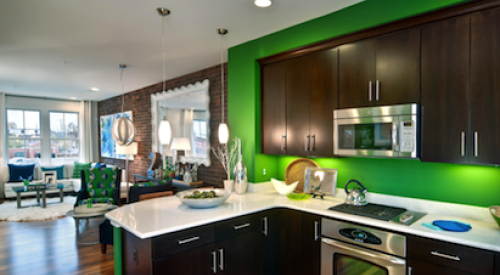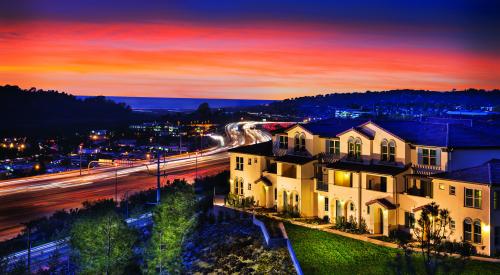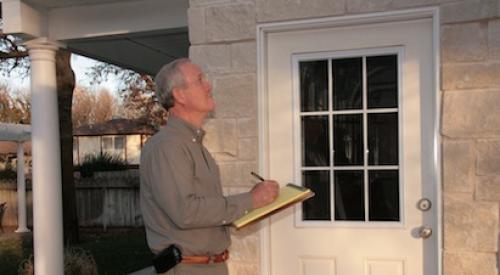 |
There's really no mystery in big builders' tendency to gravitate toward the same products and price points. “It's the history of capitalism,” says Atlanta-based builder management consultant Martin Freedland of The Berke Group. “It happens in every sector of the economy. The apartment builders have struggled with overbuilding for decades, and it's happening now in office buildings. The Hummer looked like a good idea when everybody was driving SUVs.
“We've now reached a time when the old appeal to customers — to drive 10 miles farther out of town, to get more house and a bigger yard for less money — won't work anymore,” says Freedland. “But it won't be the largest builders who find the new products that will work when the market comes back.”
Large home building companies are usually not nimble enough to be leaders in product design and marketing innovation. They try to find products that are proven winners and build them over and over to hone the high-production economies of scale that produce cost and price advantages. Investors and lenders want to fund developments with product lines that have proven track records of success. Pioneers are the guys with arrows in their backs.
However, too much of this conventional wisdom eventually leads large numbers of builders into the same products and market niches. When the merry-go-round stops, everybody falls off. “Mid-rise has the potential for overbuilding,” says Mark Hodges, who recently took over as South Florida division president for public giant Hovnanian Enterprises. “If you don't believe it, come to Florida.” Hodges says it's not just public builders who flock into the same market niches, but all productionbuilders. There are now thousands of unsold condos flooding the South Florida market.
Is Research The Answer?How do you avoid overbuilding? The obvious answer is to build something else. And consumer research — to find new housing products that customers will buy — seems the obvious answer. But not everyone agrees. “I don't think research will necessarily lead you to the right product,” says Martin Freedland. “Research says we have great demographics right now, and interest rates are still low. But housing demand is not just about need or even want. People have to be willing to invest in home ownership.
“We're under-selling nationally by about 500,000 homes a year,” Freedland says. “That should mean there's a lot of pent-up demand. There's going to be a flood of buyers someday, but nobody knows when or what the right product will be when that time comes. What they want when they're willing to buy may be different than what they want now, which is what will show up in research done today.”
Mollie Carmichael, senior vice president of Irvine, Calif.-based John Burns Real Estate Consulting, has done product research for Centex, Pulte and Lennar in California and Arizona. She says mid-rise and high-rise projects will be part of the mix when the market comes back and can be successful, but overbuilding is an ever-present danger —especially because it can take three years from project concept to completion. And a lot can change in three years, including the desires of fickle buyers.
“What you have to remember is that everything about housing has to do with affordability,” Carmichael warns. “Mid-rise is a cool concept, but in many of the projects that have been done, a big component of cost (to the consumer) was missed,” he adds, pointing to association fees and amenities such as structured parking that add up.
If Not Mid-Rise, What?Is there a housing product with the potential to excite buyers in the post-recovery era, with less danger of overbuilding? All signs point to high-density detached houses. “Logic and finances say that's what it will be,” says Carmichael, “but everything is driven by affordability, and this equation is very location-sensitive.”
The great news about high-density detached homes is that you can build them for much lower costs than any mid-rise. And the insurance cost is lower because there are no fire-wall issues. Construction can be phased because the houses are still built one at a time, and consumers will pay a premium for a detached home even over a townhouse. “People still have more pride of ownership in a detached home,” says Carmichael, “irrespective of how small the yard is. Every study ever done shows that.”
The bad news is that this is still a different business model that subdivision detached homes at four to the acre. “You have to master-plan the community very carefully,” says Carmichael. “You need a range of product sizes and densities. If everyone builds 900 square-foot houses, it's a tough sell. Builders who are pioneering these products — like California Pacific Homes — mix different sizes from 900 to 1,800 square feet, with bedroom counts ranging from one-plus-den to three.”
“People still prefer detached to attached homes,” says Carmichael. “The challenge is to understand what they want, and what they can afford, then try to bridge that gap.”
Wave of the Future?Laguna Beach, Calif.-based management consultant Doug Wilson of Next Solutions is an advocate of the Rayco model, an approach to product development and marketing developed by Wilson's longtime consulting partner, Jack Robinson, when Robinson was a vice president of Rayco Homes in San Antonio, Texas, in the 1980s. The Rayco model calls for builders to survey all home buyers in a market, including those who buy existing homes, to learn not only what buyers want, but what they actually pay for.
Wilson is now such a strong believer in high-density detached that he's currently in the final stages of entitling a project of his own in partnership with Irvine, Calif.-based MBK Homes. It will place 250 two-story homes on 23 acres in San Bernardino County, Calif. However, Wilson admits that he and MBK do not plan to start selling and building houses until the market shows signs of life, and that may depend on some resolution of the financial dilemma that faces first-time buyers today. “We've got to find a solution to the mortgage crisis before affordable housing of any kind makes sense,” says Carmichael.
Jack Haynes, Dallas-based executive vice president of the national builder division for Countrywide Home Loans, admits high-density detached (or attached) housing faces tough sledding today both for construction financing as well as mortgage money availability for buyers. “Today, this type of product will have problems on both sides,” he says.
“You'd have trouble getting construction loans to build it or mortgage money for buyers — especially in those areas of the country where there's lots of unsold standing inventory.”
Bottom Line for BuildersKeep your powder dry and do your homework. If you've never done a high-density detached community, you've probably got several years of work to do before you're ready to tackle one. Start by contacting the design professionals who specialize in this work, many who are on the West Coast. Some of the architectural firms in California see this train coming and are already working not only on product design, but how to sell the concepts to municipalities. The pipeline of new designs will be bulging to overflow before you're ready — or allowed — to build any detached product at 10 or more units to the acre, especially if your market is east of the Mississippi.
Don't be shy about advocating detached density. California consultant and Housing Giants columnist John Burns says one of the revolutions of the last few years is the number of municipalities that changed from enemies of high-density residential development to advocates.
“A lot of them started turning down projects because they weren't dense enough,” he says. “They all wanted to remake their downtowns into hip places, with lots of action. That's one reason so much mid-rise got approved. They didn't want 10 to the acre; they wanted 60! But now they're worried about that stuff because nobody wants empty buildings. That does nothing for the tax coffers. You can sell high-density detached as a compromise solution.”
This product will sell and bring people closer to that suburban downtown they want to promote as a people place if we can ever find a solution to the mortgage mess.












